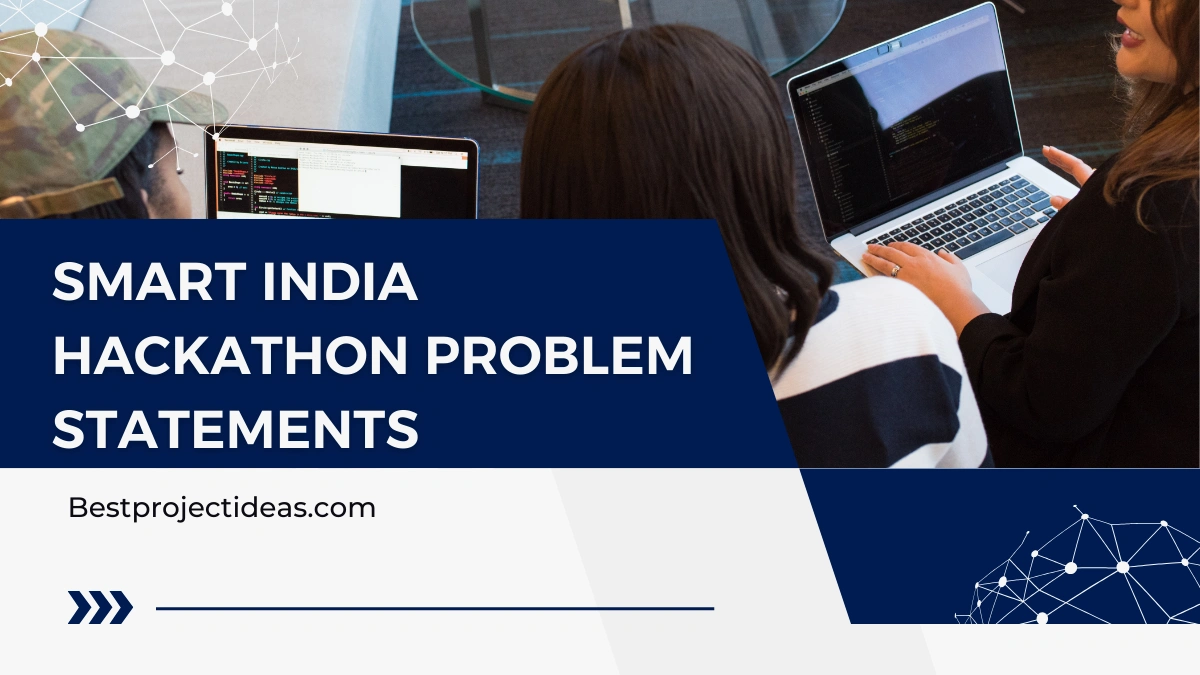
Smart India Hackathon Problem Statements are real challenges students across India try to solve. This national program brings together smart young people from colleges and universities to tackle real problems for government and industry. Each year, organizations send their hardest problems, and student teams compete to build new solutions.
The hackathon covers many areas like health, school, farming, and tech. Students form teams with classmates and spend months making simple, useful answers to these problems. When teams solve such problems well, they can win prizes and get recognition.
The program helps students learn key skills while solving problems that matter to people. Many winning ideas later become real products or services that help people in daily life and are used by many people every day. This great contest shows how young people can use their ideas and tech skills to make India better for everyone.
MUST READ: 119+ Simple Hackathon Project Ideas For Students
SIH 2025 Problem Statements with Solutions
Problem Statement 1: AI-Powered Crop Disease Detection
Category: Agriculture Technology
Complexity Level: Medium
Problem Overview
Indian farmers lose many crops because plant diseases go undiagnosed. Current checks need farm experts who are often not in remote villages. This causes a big delay between disease and care, leading to lower yields and less income for many farmers.
Solution Framework
The planned mobile app uses computer vision and machine learning to spot crop diseases with a phone camera. It processes photos on the device and gives instant results with local treatment tips. Links to nearby supply chains help farmers get treatments very fast.
Key Implementation Features
The solution works offline in places with weak networks, offers many local languages, and uses farmer feedback to keep raising accuracy over time. Weather data makes predictions better, while blockchain helps track if treatments work as planned.
Expected Impact
Using it could cut crop losses by 15-20% and shrink diagnosis time from days to minutes. The system backs sustainable farming and raises farmer income through early disease discovery.
Problem Statement 2: Rural Healthcare Data Management
Category: Healthcare Technology
Complexity Level: High
Problem Overview
Rural clinics struggle with broken patient records, causing incomplete histories and weaker care. Paper files are easy to damage and block smooth sharing of data between doctors and other healthcare providers.
Solution Framework
The digital health record system builds one patient profile that works across care points. Biometric login keeps privacy safe while letting approved providers view full histories. The platform runs well on current rural networks and devices.
Key Implementation Features
Cloud storage with local caching helps where internet is patchy. Links with telemedicine let specialists consult, while automated health analytics give community health insights for better public health planning.
Expected Impact
The system can improve care continuity for rural people while cutting medical errors by 30%. Better data collection supports sound health policy and use of resources.
Problem Statement 3: Intelligent Traffic Management for Emerging Cities
Category: Urban Technology
Complexity Level: High
Problem Overview
Tier-2 Indian cities see rising traffic jams as growth moves faster than roads. Old traffic systems cannot adjust to quick pattern changes, causing money losses and harm to the environment.
Solution Framework
The smart traffic system uses IoT sensors and machine learning to set light timing by live road conditions. Predictive tools spot future jams, while dynamic routing helps cut travel time for daily riders.
Key Implementation Features
Adaptive signal control changes with traffic within minutes soon. Citizen apps let people report incidents in real time, while links with public transit create broad, joined mobility solutions.
Expected Impact
Use could cut average commute times by 25% and lower fuel use and emissions. Better traffic flow boosts the economy and improves quality of life in fast-growing urban centers.
Problem Statement 4: Community Water Quality Monitoring
Category: Environmental Technology
Complexity Level: Medium
Problem Overview
Dirty water harms millions in India, but current systems do not give timely quality checks. Old testing is costly and slow, leaving communities at risk of waterborne disease.
Solution Framework
The IoT network places low-cost sensors at water sources and along pipes. Live data lets teams spot contamination at once, while predictive analytics find likely pollution sources.
Key Implementation Features
Automatic alerts tell officials and communities about quality issues through many channels. Community dashboards give clear access to water quality data, while links with treatment plants help better optimize purification processes.
Expected Impact
The system could cut waterborne illness by 40% through early detection. Clear, open monitoring builds community trust and supports strong, data-based water policy management.
Problem Statement 5: Digital Banking for Underserved Communities
Category: Financial Technology
Complexity Level: High
Problem Overview
About 200 million Indians lack formal banking, limiting chances to earn and save. Old banking networks cannot serve remote and poor groups, leaving people outside the system.
Solution Framework
The digital platform offers full banking through mobile phones, using other data for credit checks. Blockchain keeps transactions secure and private, while peer-to-peer lending widens access to credit.
Key Implementation Features
Offline payments help in places with weak networks. Voice tools support people with low literacy, while learning modules build banking knowledge and user confidence.
Expected Impact
The platform could bring 50 million people into formal finance within three years. Greater financial inclusion drives the economic growth and significantly lowers poverty in underserved areas.
Problem Statement 6: Personalized Learning Platform
Category: Education Technology
Complexity Level: Medium
Problem Overview
India’s schools struggle to meet many learning needs and styles, especially in underserved places. One-size-fits-all methods do not fit individual abilities or regional language needs well.
Solution Framework
The AI platform makes personal learning paths from each student’s assessments and progress. Adaptive content matches the learner’s pace, while support for many languages keeps access open across regions.
Key Implementation Features
Offline sync helps in places with limited internet. Voice-to-text tools support students with different learning needs, while progress analytics help teachers find where to improve.
Expected Impact
Use could raise learning results by 30% and reduce dropout rates. Personal approaches support inclusive education and better prepare students for new chances ahead.
Problem Statement 7: Smart Waste Management Optimization
Category: Environmental Technology
Complexity Level: Medium
Problem Overview
Indian cities make huge amounts of waste each day, yet pickup and processing are inefficient. Poor waste systems harm the environment and create public health problems.
Solution Framework
The system uses smart sensors to watch bin levels and plan better routes for collection. Predictive analytics forecast waste patterns, while citizen apps encourage sorting and segregation habits.
Key Implementation Features
Route planning algorithms cut fuel use and pickup time. Links with recycling centers support circular economy goals, while live monitoring enables responsive waste operations.
Expected Impact
The system could lower waste collection costs by 25% and raise recycling rates. Better management makes cleaner cities and significantly reduces environmental harm.
Problem Statement 8: Comprehensive Disaster Preparedness System
Category: Public Safety Technology
Complexity Level: High
Problem Overview
India faces many natural disasters, with weak early warnings and poor coordination. Not being ready leads to avoidable deaths and property damage during expected weather events.
Solution Framework
The platform blends satellite image analysis with ground sensors for accurate disaster predictions. Multi-channel alerts give wide warning coverage, while resource planning tools coordinate emergency response work effectively.
Key Implementation Features
Community reports confirm automated warnings, while mobile apps guide evacuations. After disasters, tools speed recovery planning and better resource use.
Expected Impact
Early alerts could cut disaster deaths by 50% and reduce economic loss significantly. Better readiness builds strong communities and supports faster recovery after natural events.
Problem Statement 9: Agricultural Supply Chain Transparency
Category: Agriculture Technology
Complexity Level: High
Problem Overview
India’s farm supply chain is not transparent, causing big post-harvest losses and unfair prices. Farmers get little value, while consumers face quality doubts and higher costs.
Solution Framework
The blockchain platform tracks farm goods from field to buyer, ensuring authenticity and fair pricing. Digital certificates cut fraud, while better logistics reduce post-harvest loss.
Key Implementation Features
QR codes let buyers trace where products came from. Links with current markets aid adoption, while analytics give supply chain improvement insights.
Expected Impact
Transparency can raise farmer income by 20% and lower food prices for buyers. Better efficiency supports food security and cuts farm waste.
Problem Statement 10: Student Mental Health Support Platform
Category: Healthcare Technology
Complexity Level: Medium
Problem Overview
Student mental health needs are rising across India, yet access to trained help stays limited. Stigma and low resources leave many students without needed mental health support.
Solution Framework
The digital platform offers private mental health screening and support using AI-based tools. Anonymous peer groups give community help, while links to professional counselors ensure proper care.
Key Implementation Features
Crisis steps give immediate support and guidance in urgent cases. Culture-aware features respect diverse backgrounds, while links with schools enable broad, joined support systems.
Expected Impact
The platform could improve mental health outcomes for 2 million students each year. Early help reduces academic impact and builds mental wellness skills.
Problem Statement 11: Residential Energy Management System
Category: Clean Energy Technology
Complexity Level: Medium
Problem Overview
Homes use 40% of India’s energy due to wasteful patterns and low use of renewables. High power bills and carbon emissions call for smarter energy management.
Solution Framework
The smart system watches energy use and optimizes appliance schedules with machine learning. Solar links and battery storage boost renewable use, while demand response programs help ease strain on the grid.
Key Implementation Features
Smart automation changes energy use based on price and demand. Real-time monitoring gives clear, useful actions, while grid links support broader energy management goals.
Expected Impact
Use could cut home energy use by 30% and significantly lower electricity costs. Broad adoption backs national renewable targets and emission reduction goals.
Problem Statement 12: Universal Digital Identity Platform
Category: Governance Technology
Complexity Level: High
Problem Overview
Document checks in India take too long and invite fraud, creating barriers to government services. People face big daily challenges with complex paperwork across many agencies.
Solution Framework
The blockchain platform offers secure document storage and verification with biometric login. Links with government services allow smooth access, while digital signatures cut processing time.
Key Implementation Features
QR codes confirm document authenticity, while mobile apps give citizens control of data sharing. APIs connect many government services through one simple, unified central platform.
Expected Impact
The system could cut service delivery time by 70% and remove document fraud. Better access empowers citizens and makes government efficient.
Problem Statement 13: Industrial Predictive Maintenance System
Category: Manufacturing Technology
Complexity Level: High
Problem Overview
Equipment breakdowns cause production losses and safety risks in Indian factories. Fixing only after failure leads to surprise downtime and costly emergency repairs.
Solution Framework
The predictive system uses IoT sensors and machine learning to warn of equipment failures before they happen. Automated scheduling improves maintenance tasks, while links with systems make rollout smooth.
Key Implementation Features
Real-time anomaly detection spots issues early, while maintenance optimization significantly reduces downtime. Mobile apps give field technicians predictive insights and clear, practical maintenance guidance.
Expected Impact
Predictive maintenance can cut equipment downtime by 40% and lower maintenance costs. Better reliability improves manufacturing strength and worker safety.
Problem Statement 14: Skills-Based Employment Matching Platform
Category: Employment Technology
Complexity Level: Medium
Problem Overview
India has large skill gaps, with millions lacking needed abilities for new industries. Old job matching does not fix skill alignment or career growth needs well.
Solution Framework
The platform checks each person’s skills and finds gaps while giving personal learning paths. AI matching links candidates to roles based on skills and career goals accurately.
Key Implementation Features
Work with industry gives live skill demand data, while certifications match market needs. Analytics predict skill trends and guide smart education policy development.
Expected Impact
The platform could raise matching efficiency by 50% and narrow skill gaps. Better alignment drives economic growth and supports individual career progress.
Problem Statement 15: Dynamic Parking Management Solution
Category: Urban Technology
Complexity Level: Medium
Problem Overview
Parking issues add to traffic jams and citizen frustration across Indian cities daily. Poor space use and no real-time info seriously make mobility worse in fast-growing urban areas.
Solution Framework
The smart parking system uses IoT sensors to show live space availability in a mobile app. Dynamic pricing improves space use, while automatic payments make parking simple.
Key Implementation Features
Links with navigation guide drivers to open spots, while predictive analytics optimize parking supply. Revenue tools help cities design and manage parking policies effectively.
Expected Impact
Smart parking could trim traffic by 15% and raise parking revenue. Better mobility supports economic activity and improves city life and livability.
Past Winning Projects & Case Studies Of SIH
Recent SIH 2024 Winners with Implementation Success
Heritage Institute of Technology, Kolkata achieved a double victory at the Smart India Hackathon 2024, a national student contest for practical solutions. Team Paradox Innovator was a joint winner for problem SIH1582.
This challenge was given by the Department of Smart Cities Mission under the Ministry of Urban and Housing Affairs. Their solution was a simple system to check the grounding health and to alert staff quickly. This project helps fix serious electrical safety problems in smart cities.
Solar Masters team won at the Smart India Hackathon 2024. The team developed tools for renewable energy improvement and smooth use. Their work directly supports India’s green goals and also helps the power network meet real world challenges. The project shows how student ideas can improve energy systems.
Notable Project Implementation Examples from Previous Years
One winning team shared: “None of us had joined any hackathon before and this victory was very special for us, as we were winners and got a chance to use our idea at ISRO.” This example shows a direct path from SIH win to real world deployment with government agencies.
Machine learning projects from SIH have included crop disease prediction, dynamic route planning, and real-time monitoring of infrastructure development. These projects show the wide range of technical solutions that are being built and put into use by partners and agencies. These efforts help cities, farmers, and planners make better choices and save money now.
MUST READ: 109+ Best Physics Investigatory Project Ideas For Students
Summary
Smart India Hackathon problem statements are real problems that need clear solutions from college students across India. This large event helps young people solve everyday problems by working with government offices, local groups, and private companies. Each year, hundreds of problem statements cover areas like health, education, and technology.
Students choose problems they want to solve and make new ideas using computers and simple machines, and test them. Some solutions use smart computer programs to help farmers grow more food, stop fraud in public programs, or build health chatbots that teach people in villages and cities.
The SIH problem statements with solutions give students a chance to help make India better while showing their skills. This contest asks students to think in new ways and use their computer skills to help the whole country. Winners get praise and may see their ideas used in real life to fix important problems today

